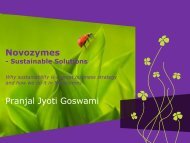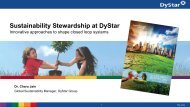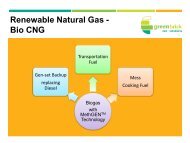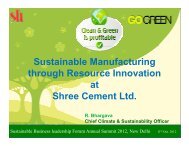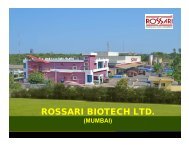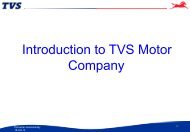Dr. Venkateswaran Narayanan, Head Corporate Research, ABB
Dr. Venkateswaran Narayanan, Head Corporate Research, ABB
Dr. Venkateswaran Narayanan, Head Corporate Research, ABB
- No tags were found...
Create successful ePaper yourself
Turn your PDF publications into a flip-book with our unique Google optimized e-Paper software.
<strong>Venkateswaran</strong> <strong>Narayanan</strong>, India <strong>Corporate</strong> <strong>Research</strong> Centre, <strong>ABB</strong>, Bangalore. 11 Oct 2012Leveraging Technology for SustainabilitySustainable Leadership Forum Annual Summit 2012
A global leader in power and automation technologiesLeading market positions in main businesses• 145,000 employees in about 100countries• $38 billion in revenue (2011)• Formed in 1988 merger of Swiss andSwedish engineering companies• Predecessors founded in 1883 and1891• Publicly owned company with headoffice in Switzerland© <strong>ABB</strong> GroupOctober 18, 2012 |Slide 2
Power and productivity for a better world<strong>ABB</strong>’s visionAs one of the world’s leading engineering companies, wehelp our customers to use electrical power efficiently, toincrease industrial productivity and to lower environmentalimpact in a sustainable way.© <strong>ABB</strong> GroupOctober 18, 2012 |Slide 3
How <strong>ABB</strong> is organizedFive global divisionsPowerProducts$10.9 billion36,000employeesPowerSystems$8.1 billion20,000employeesDiscreteAutomationand Motion$8.8 billion29,000employees(2011 revenues, consolidated; including Thomas & Betts revenue for LP division)• <strong>ABB</strong>’s portfolio covers:• Electricals, automation, controlsand instrumentation for powergeneration and industrialprocesses• Power transmission• Distribution solutions• Low-voltage productsLow VoltageProducts$7.7 billion31,000employees• Motors and drivesProcessAutomation$8.3 billion28,000employees• Intelligent building systems• Robots and robot systems• Services to improve customersproductivity and reliability© <strong>ABB</strong> GroupOctober 18, 2012 |Slide 4
Developing sustainability of products and operationsLowering environmental impact and costsSustainability in product development• Focus on resource and energyefficiency of equipment over life cycle• Independently verified EnvironmentalProduct Declarations for main productsSustainability in <strong>ABB</strong>’s operations• Cuts targeted in use of energy, rawmaterials, hazardous substances• eg, China: 63% cut in energy use per unitof revenue between 2002 and 2010© <strong>ABB</strong>
17,20012,50034,350Tackling society’s challenges on path to low-carbon eraHelping customers do more using lessRise in electricity demand by 2035(under current policies)Source: IEA, World Energy Outlook 2011Terawatt-hour(TWh)30,00020,000+99.7%<strong>ABB</strong> power and automationsolutions are:• Meeting rising demand forelectricity• Increasing energy efficiencyand reducing CO 2 emissions• Improving productivity toraise competitiveness ofbusinesses and utilities10,0002009 2035Electricity demand is calculated as the total gross electricity generated less own use in the production of electricity and transmission, anddistribution losses.© <strong>ABB</strong> GroupOctober 18, 2012 |Slide 6
Improving capacity, reliability and efficiency in the gridA pioneer in smart technologiesChallenge• China: deliver 6,400 MW ofhydropower over 2,000 km<strong>ABB</strong> solution• Transmission at ultrahighvoltage• Minimal losses with directcurrent solution• US: Increase capacity andreliability for Texas utility• World’s largest installationenabling existing lines tocarry more power• Also enables integrationof renewable energy• India: Improve reliability ingrid serving state ofKarnataka (pop. 53 million)• Network managementwith real-time control• Key building block forsmart grid© <strong>ABB</strong> GroupOctober 18, 2012 | Slide 7
Renewable energyKey growth driver for both power and automation• Generation andtransmission solutions for:• Hydro• Wind• Solar• WaveProject examples• Xiangjiaba-Shanghai (China)• Wind Capital (US)• La Sugarella (Italy)• Pelamis wave energy (Portugal)<strong>ABB</strong> scope• Grid connection• Transformers• Turnkey execution• Customized generators© <strong>ABB</strong> GroupOctober 18, 2012 |Slide 8
Ground-breaking and nation-building projectsPushing the boundaries of technologyMine hoist forlargest potash mineLargest batteryFirst commercialwave power plantFirst platform connectedto mainland gridLongest underwaterpower linkMost remote offshorewind farm linked to gridEurope’s largestthermal solarpower plantLargest SVCinstallationAutomation of largestalumina plantLongest and highestcapacity power linkLongest conveyor beltLargest SCADAnetworkLargest gearless milldrive (for crushing ore)First 600 kVpower linkLargest reverseosmosisdesalination plantPower and automationof largest chemicalcellulose plantLongest undergroundpower linkSubstation in world’stallest building© <strong>ABB</strong> GroupOctober 18, 2012 |Slide 9
Innovation is key to <strong>ABB</strong>’s competitive advantageLeadership built on consistent R&D investment• More than $1.3 billion invested annually in R&D• 7,500 scientists and engineers• Collaboration with 70 universities• MIT (US), Tsinghua (China), KTH Royal Institute ofTechnology (Sweden), Indian Institute of Technology (NewDelhi), ETH (Switzerland), Karlsruhe (Germany), AGHUniversity of Science and Technology (Poland)© <strong>ABB</strong> GroupOctober 18, 2012 |Slide 10
Today’s energy challenge – growing demandElectricity demand rising twice as fastEurope andNorth America11% 31%China105% 195%SouthAmerica56% 81%M. East andAfrica73% 131%India126% 282%Growth in primaryenergy demandGrowth in electricitydemandIEA forecast2006-30© <strong>ABB</strong> GroupOctober 18, 2012 | Slide 11
Annual emission of CO 2 in GigatonsMajor challenge: environmental concerns1098Source: IPCC “Mitigationof Climate Change”,Cambridge UniversityPress, 2007Electricity plants765432101970 1980 1990 2000Industry (excl. cement)Road transportResidential and service sectorDeforestationOthersRefineries etcInternational transportCO 2 is responsible for 80 percent of all greenhouse gas effectsMore than 40 percent of CO 2 is generated by traditional power plantsElectric power generation is thelargest single source of CO 2 emissions© <strong>ABB</strong> GroupOctober 18, 2012 | Slide 12
Today’s Energy ChallengeDilute link between growth, energy use and emissionsMeeting these challenges requires:• Reduce the correlationbetween economic growthand energy use• Reduce the correlationbetween energy use andemissionsEnergy Energy EfficiencyefficiencyRenewable Renewable energy Energy sourcesEnergy efficiency and renewable power generationcould provide almost 80 percent of the targeted reduction© <strong>ABB</strong> GroupOctober 18, 2012 | Slide 13
Power GenerationIndian Scenario• Total installed capacity: 157.2 Gw e (2010)• Growth projections• 78,700 MW addition during 11th Plan (2007-11)• 83,000 MW addition during 12th Plan (2012-16)• 100,000 MW addition during 13th plan (2017-21)• By 2020, resulting increase in CO2 by ~1500 million tons / year© <strong>ABB</strong> GroupOctober 18, 2012 | Slide 14Ref: http://www.oifc.in/Resources/News/Sector-in-Focus-Indian-Power-Industry
Current Status of Thermal Power Plants in IndiaEfficiency AssessmentCase study of 60 coal fired plants across India© <strong>ABB</strong> GroupOctober 18, 2012 | Slide 15BestperformerModerateperformerVariableReturn toScale ScoreSmall< 500 MWCapacityMedium500-1000 MWLarge> 1000 MW1 5 7 70.8-0.99 4 7 10Laggards < 0.8 12 7 119212021 21 18 60• Overuse of coal, secondary fuel oil and auxiliary power• 33% (laggards) have potential to reduce inputs as much as 43%• Primary issues –• sub-critical technology, poor combustion, poor conditionmonitoring, ageing, deteriorated aux equipments, sparseenergy audits, lack of organization processes & best practices* Reference:N. Shrivastava, S. Sharma and K. Chauhan, “Efficiency assessment and benchmarking of thermalpower plants in India”, Energy Policy, Vol.40, pp.159-176, 2012, Elsevier.
Energy Efficiency Improvements forPower PlantsTechnology based solutions
Energy Efficiency - Technologies for Power PlantsBoiler Life MonitoringHelps in maintenance & planningCombustion OptimizationModel based controlImproved heat rate of0.25-1.5%Burner Mgmt SystemsFlame MonitoringCarbon in Ash MonitoringReal-time, non-extractive,highly accurate carbonmeasuring in fly & bottom ashEmission Monitoring & ControlContinuous and quantitativemeasurement CO, Nox, SOx and O2Boiler startup & control10-20 % reductionin fuel and auxiliary powerfor boiler startupCoal Quality & Flow MonitoringSoot Blowing AdvisorModel based heat transfercalculationsOptimized soot blowing forimproved efficiencyTurbine DiagnsoticsTracks turbine life consumptionbased on fatigue, creep of turbinecomponentsImproves maintenance planningTensoMaxReal time rotor thermal andcentrifugal stress monitoringTurbine Startup cost reduction
Energy Fingerprinting & AnalysisEnd to end solution© <strong>ABB</strong> GroupOctober 18, 2012 | Slide 18
Energy Efficiency Improvement ServicesMethodologyPlant DataData Pre-processingEnergy AssessmentBenchmarking and GapAnalysisCost SavingsCalculationReporting• Quick identification of opportunities for energyefficiency improvements by• Energy flow distribution analysis• Efficiency, KPIs and losses calculation• Establishing benchmark• Identifying gaps/opportunities by comparingperformance against standards/benchmark.• Performing cost-benefit analysis and recommendsolutions• Implementation of energy efficiency improvement plan• Continuous monitoring & interventions for optimalperformance© <strong>ABB</strong> GroupOctober 18, 2012 | Slide 19
Solar Steam AugmentationCarbon reduction thro renewables
Fossil Fired Power PlantsScope for Solar Steam AugmentationBoilerSteamTurbine• For feed water pre-heating as well as directinjection into turbines• Most modern steam cycles are able to handleincreased steam mass flows (boosted poweroutput) with up to around 5-10% above therated turbine capacitySolar Field• Solar integration only includes solar field,retrofitting and control system costs (40% lesscompared to stand-alone solar thermal powerplant)HPFWHDeaeratorLPFWH• There are lesser issues related to fluctuationof power generation compared to standalonesolar power plantsSolar FieldSolar Field• Fuel Savings as well as reduced exergy lossby reduced turbine extractions© <strong>ABB</strong> GroupOctober 18, 2012 | Slide 21Significant CO2 reduction potential150 Million tons / year per 500 MW power plant
Power Generation Solar Steam AugmentationTechnology challengesSolar augmentation / technologytradeoff• Identification of the best possiblesolar thermal technology• Design optimization and integrationstrategies• Potential savings economic benefitsstudy and recommendationsAdvanced control and operations• Overall steam integrated systemoptimization through advancedcontrol and optimal allocation of solarsteam• Integration with the DCS for ease ofoperation and maintenance© <strong>ABB</strong> GroupOctober 18, 2012 | Slide 22
Power & Water using solar energyRenewables for sustainability
Power and WaterSolar Energy is the Key to SustainabilityWaterSolarEnergyBatteryStorageReverse OsmosisLightingPVPowerCold StoragePowerIrrigationWaterPumpingThermalStorageWaste HeatWaterSmall ScaleIndustriesSolar ThermalPower BlockThermal Desalination© <strong>ABB</strong> GroupOctober 18, 2012 | Slide 24
Sustainable Power and WaterSolar Solution for IndiaPotential forSustainablePower andWaterSolutionCoastline: 7517 kmPopulation: ~ 0.2 billion© <strong>ABB</strong> GroupOctober 18, 2012 | Slide 25Source: NREL




